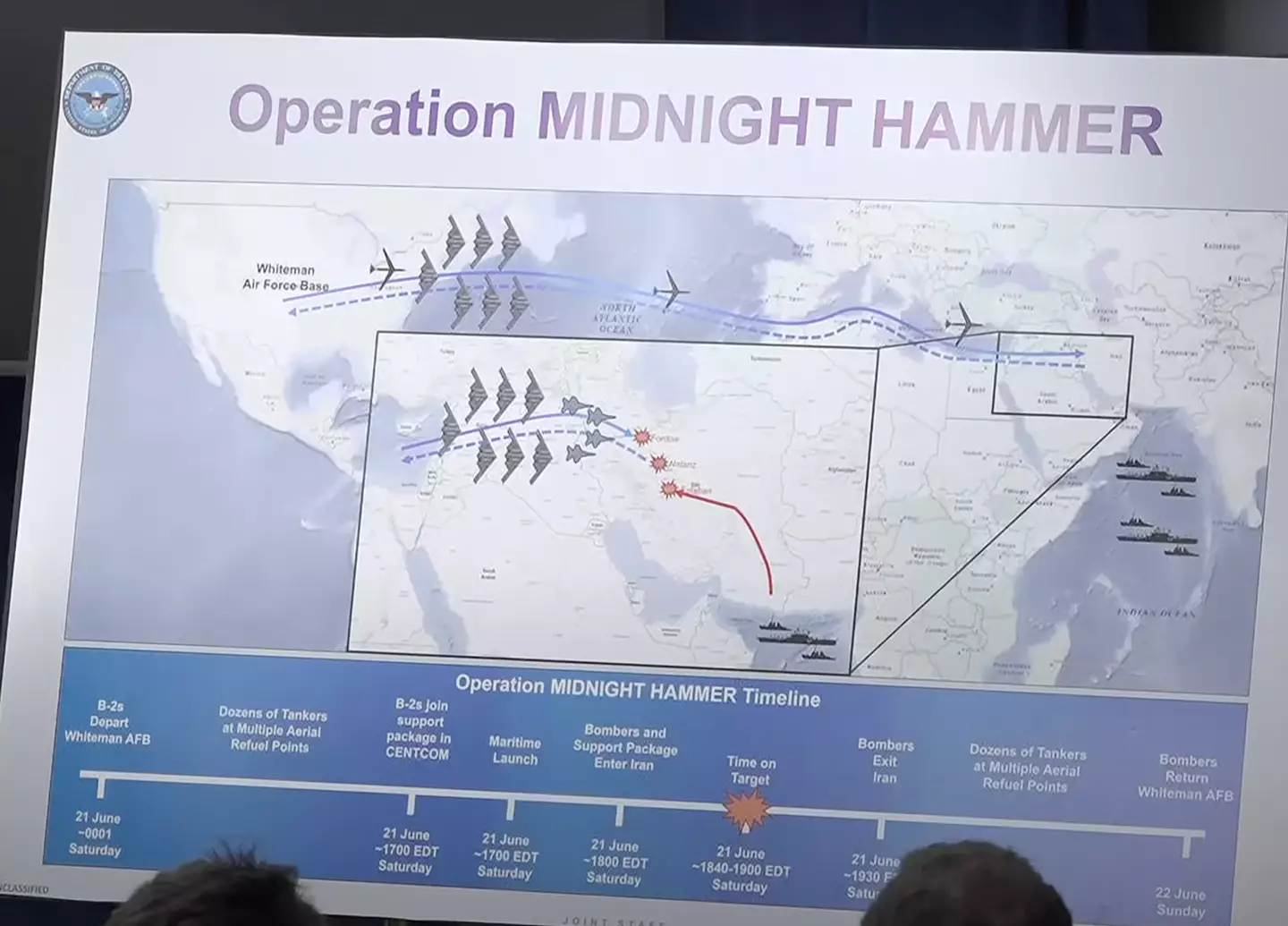When President Donald Trump confirmed a “very successful attack” against three Iranian nuclear sites, few details were released. But a follow-up Pentagon briefing revealed an intricate, sprawling operation—Operation Midnight Hammer—the largest B‑2 bomber mission ever executed, and shrouded in strategic subterfuge.
This action, covert until its execution, unfolded deep in the night, stretching over 18 hours and spanning continents. Here’s how it all unfolded—and why U.S. officials say it may redefine deterrence in the Middle East.
1. The White House Confirmation
On June 21, President Trump told the nation his forces had bombed Fordow, Natanz, and Esfahan, declaring that Iran’s nuclear enrichment facilities were “completely and totally obliterated.” taskandpurpose.com+15reuters.com+15businessinsider.com+15axios.com+10en.wikipedia.org+10theguardian.com+10
Iran confirmed the sites were struck but minimized the damage, with Foreign Minister Abbas Araghchi warning of “everlasting consequences” describing the U.S.’s actions as “extremely dangerous, lawless and criminal.” apnews.com

Defense Secretary Pete Hegseth held a press conference following the US airstrikes on Iran (Andrew Harnik/Getty Images)
2. Operation Midnight Hammer—Highly Classified Until Launch
Defense Secretary Pete Hegseth revealed the mission’s official codename—Operation Midnight Hammer—during a Sunday Pentagon press conference.
He emphasized that mission planning included secret deception routines. Some B‑2 bombers were even sent west toward Guam, serving as decoys while the real strike force flew eastward. omni.se+15reuters.com+15thedailybeast.com+15
B‑2s launched shortly after midnight ET from Whiteman AFB, Missouri. The mission required 18 hours of continuous flight with multiple mid-air refuelings—reaching Iran undetected. en.wikipedia.org+1en.wikipedia.org+1
Hegseth confirmed the mission remained so confidential that only a handful of planners in Washington and Tampa knew the plan’s details before Saturday evening. cbsnews.com+10reuters.com+10thedailybeast.com+10
3. Mission Architecture: Deception, Coordination, Surprise
Gen. Dan Caine, Joint Chiefs of Staff Chair, summarized the layered approach:
-
A group of seven B‑2s, flown in radio silence.
-
Decoy stealth flights: Some B‑2s diverted toward the Pacific as ruse forces. defence-blog.com+3reuters.com+3businessinsider.com+3
-
A hidden submarine-launched Tomahawk strike on Esfahan just as bombers entered airspace. bloomberg.com+7defense.gov+7businessinsider.com+7
-
Fighter jet escorts sweeping ahead, suppressing potential Iranian SAM threats. reuters.com
-
No interference detected: Iran didn’t scramble fighters or fire missiles.
4. Massive Ordnance, Massive Impact
Once inside Iran:
-
At ~6:40 pm ET (2:10 am Iran time), two GBU-57 Massive Ordnance Penetrator (MOP) bombs struck beneath the fortified tunnels at Fordow. Each weighs 30,000 lb. foxnews.com+12defense.gov+12breakingdefense.com+12
-
In total, 14 bunker-busting MOPs hit Fordow and Natanz. apnews.com+7defense.gov+7breakingdefense.com+7
-
The submarine’s Tomahawk missiles hit Esfahan shortly after, keeping the element of surprise intact. taskandpurpose.com+6defense.gov+6businessinsider.com+6
An estimated 75 precision-guided weapons were delivered during the mission. omni.se+6taskandpurpose.com+6defense.gov+6
Hegseth called it the largest-ever operational use of B‑2 bombers, second only to the 9/11-era mission. cbsnews.com+10reuters.com+10abcnews.go.com+10

The strikes were part of the US Department of Defense’s ‘Operation Midnight Hammer’ (Department of Defense)
5. Massive Air Force Involvement, Unmatched Coordination
Gen. Caine highlighted the mission’s scale:
-
125+ U.S. aircraft took part, including B‑2s, fighter jets, tankers, surveillance aircraft, and support crews. theguardian.com+15reuters.com+15youtube.com+15
-
Covert coordination included contributions from U.S. Strategic, Transportation, Cyber, and Space commands. defense.gov
-
A submarine-launched Tomahawk salvo (two dozen missiles) destroyed Esfahan’s surface infrastructure. theguardian.com+10defense.gov+10businessinsider.com+10
6. Results: Severe Damage, Ongoing Assessment
Gen. Caine described “extremely severe damage” at all three nuclear sites—but cautioned it’s too early to confirm if nuclear capabilities are completely eliminated. reuters.com+3politico.com+3theguardian.com+3
Meanwhile, Hegseth was more aggressive, stating that he believed Iran’s nuclear ambitions were “obliterated.” breakingdefense.com+9reuters.com+9theguardian.com+9
The difference over language reflects a rapidly shifting evaluation process.
7. Iran’s Response: Silence—and Threats
Iranian commanders acknowledged the strikes but claimed no major damage, while Araghchi called them a “lawless” act with “everlasting consequences.” apnews.com
No Iranian counterstrikes were immediately reported, but Tehran announced moves such as:
-
Launching 20 missiles at Israel in retaliation, with casualties reported. reuters.comtheguardian.com
-
Iran’s parliament suggesting closure of the Strait of Hormuz—which would disrupt global oil flows. theguardian.com
8. Regional Repercussions and U.S. Preparations
-
Gulf-region U.S. troops remain on high alert, and American military assets were shifted to deter further escalation. reuters.com
-
The White House emphasized that the strike was not aimed at regime change but at targeting nuclear infrastructure. politico.com+3apnews.com+3theguardian.com+3
-
Vice President JD Vance said the strike likely delayed Iran’s nuclear weapon goals by years—with an opening for renewed negotiations. apnews.com
-
Oil prices jumped amid fears of supply disruption, and international leaders—including European allies—called for diplomatic de-escalation.
9. Constitutional Controversy and Political Debate
Despite GOP backing, several Democrats and a few Republicans raised constitutional concerns:
-
Critics contend the strike lacked congressional authorization, violating the War Powers Act. en.wikipedia.org+3thedailybeast.com+3politico.com+3
-
Representative Alexandria Ocasio-Cortez called it an “impeachable offense.” politico.com
-
Others questioned the strategic value—especially after intelligence suggesting Iran wasn’t actively developing nuclear weapons at the time.
10. Strategic Takeaways: A Show of Capability and Resolve
Operation Midnight Hammer sends multiple strategic messages:
-
Deterrence by punishment: The U.S. showed it can strike deeply and precisely—even within fortified, underground sites.
-
Rapid deployment: The mission illustrates U.S. capacity for long-range, coordinated strikes on short notice.
-
Escalation control: By combining military action with diplomatic signals, the U.S. aims to avoid full-scale war while maintaining pressure.
-
Cyber and command readiness: Use of stealth platforms and decoys highlights a new model of multi-domain warfare.
Final Word
Operation Midnight Hammer marked a pivotal moment in modern warfare and geopolitics:
-
A covert mission realized in minutes, but born of years of preparation.
-
A multitiered deception and strike strategy spanning land, air, and sea.
-
A watershed example of how the U.S. might manage nuclear threats in a post-Cold War era.
The destruction of Iran’s nuclear infrastructure appears significant, but the long-term impact—on Iran’s capabilities, regional stability, and global diplomacy—remains to be seen. Whether this moves the world closer to peace or deeper into conflict depends on what comes next: retaliation, negotiation—or more strikes?





